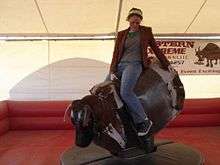Mechanical bull

A mechanical bull, also known as a rodeo bull is a machine that replicates the sensation of riding a bucking animal, such as a rodeo bull or horse popularized by Sherwood Cryer. It is usually powered by a variable-speed electric motor. Padded flooring is often installed around the equipment in order to reduce the likelihood of injury to those thrown off it.
A "quick stop" motor allows the operator to safely control the ride and ensure safety for the rider; this feature allows the operator to stop the ride prior to a rider being thrown. The trained operator at the variable speed control box regulates the unit's Buck-and-Spin speed, as well as spin direction. The equipment has the capability of starting rides very slowly and speeds can be advanced according to a rider's ability. It can go slowly and simply spin for beginners and run at greater speed for experts.
Prior to the development of a mechanical bull, a simpler device was created by attaching ropes (sometimes a rope-and-pulley system) to the ends of a large barrel, suspending it from four points, often tall posts or the rafters of a barn. A saddle or bucking equipment would be added, and then a rider would straddle the barrel. Two to four other people would move the barrel by pulling on the ropes to emulate the movement of an animal. This "bucking barrel" is still also used as a less-expensive option for practice and entertainment.
Mechanical bulls have existed for decades as a training device for rodeo competitors, as they enable a rider of rough stock (bucking horses and bull riding) to enhance rodeo performance and refine skills without the risk and unpredictability of a live animal. Although mechanical bulls are still routinely used for rodeo training, they are also utilized as an amusement ride, both as a mobile rental (i.e., party entertainment) and stationary entertainment found in bars, restaurants, and clubs; these may be surrounded by an blown-air inflated structure similar to a "bounce house" or foam pits for safety. There is a modified, less dangerous style used for children's parties, usually with a one-minute timer. Children remove their shoes to get on. They hold a rope or peg on the shoulder or neck of the machine, and the person who stays on for the whole minute without falling off wins a small prize.
As a form of entertainment, the mechanical bull often includes a saddle (used only in saddle bronc riding, not bareback or bull riding) and often a model head of a bull, complete with horns. One of the earliest uses as a form of entertainment was at Bertrand Island Amusement Park in New Jersey), where a mechanical bucking bronco ride was introduced in the 1930s, under the name of "Ride 'Em Cowboy!".[1]

The mechanical bull as an entertainment device as well as the commercial use of mechanical bulls gained popular appeal with the release of the 1980 movie Urban Cowboy. In this movie John Travolta and Debra Winger demonstrated the art of riding a mechanical bull to the larger movie-going population. The mechanical bull featured in this movie was the El Toro brand of mechanical bull. This brand of mechanical bull is still in circulation, but does not carry the same safety features that are available on more current models
"Bucking bronco" or "bronc" is cowboy slang for a horse that throws a person around.[2]
Cultural references
Mechanical bulls can be seen in the films Urban Cowboy, Stir Crazy, and Charlie's Angels: Full Throttle. In the movie Barnyard, in the night barn, a "Mechanical Man" is seen (as the main characters are cows). In the television show Strangers with Candy, Jerri Blank's P.E. class is seen to have mechanical bull riding. Feeder's 2012 music video for their single "Idaho", features actor Daniel Mays riding a mechanical bull.
| Wikimedia Commons has media related to Mechanical bull. |
Safety
Although injuries from mechanical bulls are relatively rare, there are a variety of ways that a person can be injured while riding a mechanical bull. These injuries can be caused by falling on the ground, striking the bull or getting caught on it, or injuries caused by the bucking motion.[3] In 2003 a 28-year-old man was paralyzed after being thrown from a mechanical bull at a county fair. He sued for $50 million in damages claiming that the ride was deceptive because there is no warning about the steel frame underneath the pad.(The man struck this steel frame when he was thrown from the bull.) [4] Because of the risk of injury many venues require varying levels on insurance coverage to keep themselves protected. There are also very few insurance companies that will insure mechanical bulls because of the risk involved.[5]
There are however mechanisms in the bulls that keep the risk of injury much lower. Many of the bulls have continuous pressure airbags, rounded padded body designs and also controls that will control the speed and bucking motion of the mechanical bulls. Also operator training on safety is also provided through some of the insurance companies that insure mechanical bulls.[6]
See also
References
- ↑ Martin Kane and Laura Kane (2000). Greetings from Bertrand Island Amusement Park. Arcadia Publishing. p. 68. ISBN 0738504688.
- ↑ Lester V. Berrey and Melvin Van den Bark (1953). The American Thesaurus of Slang: A Complete Reference Book of Colloquial Speech. New York: Thomas Y. Crowell Co. p. 839.
- ↑ The Free Dictionary By Farlex | http://medical-dictionary.thefreedictionary.com/Mechanical+Bull+Injuries
- ↑ NWI Times | http://www.nwitimes.com/news/local/family-sues-over-mechanical-bull-accident/article_fb086aba-dfa8-5a8a-a8a9-f4c8b003cab7.html
- ↑ Insurance for Mechanical Bulls | http://www.insuranceformechanicalbulls.com/
- ↑ JT Mechanical Bulls | http://www.mechanicalbullguy.com/FAQ.html